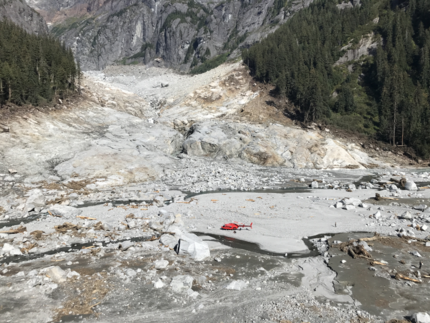Research topic
How fast can mountain rivers recover from large earthquakes?
We study how rivers near Nepal's second largest city of Pokhara adjusted to several strong medieval earthquakes that triggered massive pulses of river aggradation, burying streams beneath tens of metres of sediment. Most of modern Pokhara is built on this medieval debris.
Where do natural dams form and fail?
We classify time series of satellite images to map previously unreported failures of moraine-dammed lakes in the Himalayas. Sudden dam burst leave tell-tale sediment tails in the landscape. Manipulating digital elevation models also helps us to detect those Himalayan river reaches prone to the largest lake-outburst impacts.
How can we tell apart deposits of rockslides and rock glaciers?
Tongue-shaped, bouldery deposits abound in many semi-arid mountains. In the central Argentine Andes we explore how to distinguish rockslides from rock glaciers, as confusing the two distorts assessments of permafrost distribution and rock-slope stability. In Central Asian mountain ranges we investigate the conditions that enable rock glacier to block major rivers and create potentially unstable lakes.
How do explosive eruptions disturb pristine rainforests?
We quantify how rivers flush particulate organic carbon contained in large wood and soils after the recent explosive eruptions of Chaitén, Puyehue, and Calbuco volcanoes in south-central Chile. We further track how temperate rainforests smothered by tephra give rise to increased landsliding several years after the eruptions.
How do earthquakes affect forests and water?
We recently demonstrated how a strong subduction earthquake released large volumes of excess water into Chilean rivers, thus boosting runoff during the dry season. Dendrochemical data help us pinpoint the time of past earthquakes in the isotopic composition of tree rings, thus exploring a novel marker for palaeoseismology.
How rare are flash floods and debris flows in southern Germany?
Heavy rainfalls triggered numerous flash floods and debris flows in southern Germany in summer 2016. Within the interdisciplinary team in the DFG Graduate School NatRiskChange, we examine the geomorphic impacts and average return periods of such rare events.
Do typhoons and earthquakes set the pattern of landslides in Japan?
With event synchronisation of complex spatial networks we express how extreme typhoon rainfall moves throughout Japan, and how this rainfall affects the distribution of landslides. On Kyushu, we quantify mechanistic links between the direction of seismic waves and landslides during the 2016 Kumamoto earthquakes.
In September 2022, the research group Geohazards undertook a survey of a rock avalanche that descended onto a glacier near Hyder, Alaska (Video by Georg Veh)

